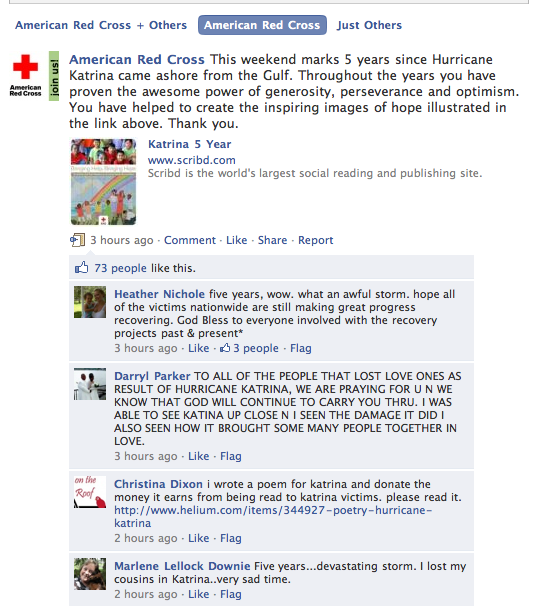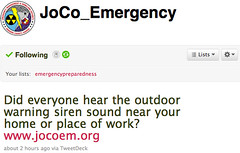As government emergency management offices and non-profit disaster relief groups increasingly utilize Twitter and Facebook as part of their operations, I thought I would check with some leading practioners in the field to see how the two social media platforms are being employed in their work with the public.
It turns out that in most cases the two services are being utilized in somewhat different ways by different types of external users. Twitter is being used mostly as an informational source with speed and news being paramount for more of an official audience, while Facebook pages tend to be more of a place for public discussion and community building with more depth (ie. multi-media) and emotional involvement often for average citizens. But in a crisis, the two platforms will be used similarly to distribute and solicit emergency information. Both, officials say, have been very helpful to their informational outreach to the public.
Here are the e-mail responses about Twitter and Facebook from some of the emergency management experts I contacted:
Jeremy J. Heidt, Tennessee Emergency Management Agency – ”We are seeing quite a difference in what TEMA’s social media followers and fans are looking for from our agency, but that may be due to how we are interacting on those platforms. We have 355 followers on Twitter, but a majority (>75%) of them are what I would call information gatherers, like yourself, looking for official information to share through their own distribution channels.
For example, our Twitter followers include the Associated Press and CNN Southeast Desk, as well as various federal, state and local agencies or officials. The general public makes up a small percentage of the direct audience, though they are welcome to receive the messages. TEMA primarily uses Twitter as an automatic distribution mechanism –using Google Feedburner and RSS feeds — for any information that has been updated, such as pictures or maps on Flickr, any official state news releases on TN.Gov or blog postings to TEMA’s website, as well as FEMA releases involving Tennessee and earthquake notices in the region from the U.S. Geological Service.
During the recent flooding, I repeatedly told media outlets that following TEMA on Twitter would ensure they received immediate notice of any new information that we had released. This cut down tremendously on the number of repeat phone calls from those media outlets looking for just routine updates to some previously released information. By utilizing the Twitter lists, I’m also able to get immediate feedback by watching what media outlets are saying about an event, as it is happening. We don’t have a lot of two-way conversations via Twitter though.

Tennessee Emergency Management Agency Twitter page.
The Facebook page, TNDisasterInfo, has 2,483 fans, but the daily impressions are 9,755. This site has much more grassroots appeal to its users. They are able to comment and give direct feedback via Facebook. Sixty-five percent of the fans are female, and most reside in Tennessee. I definitely think that how TEMA uses and interact through social media will continue to change.
In the future, I think emergency organizations will have to monitor social media, like Twitter or others, for ’emergency’ communications from our citizens. We need to adapt to how the public chooses to communicate, or we will lose a piece of situational awareness that is vital to any successful emergency operation.”
Gloria Huang, American Red Cross — “Yes, we definitely have a different community on Twitter versus Facebook. Our Facebook following [202,687] consists of a lot of Red Cross volunteers, donors, workers – people with some personal tie to the organization. As a result, they are incredibly interactive and love sharing and chatting with each other on our Facebook page. Because of that, we try to tailor our content on Facebook to encourage community building and we try to give them interesting topics to talk about. In contrast, our Twitter following [177,206] love to see more disaster-focused tweets. They are interested in hard facts and timely information that they can pass on. That is most of the reason why our Twitter account is so disaster-focused.
The nature of a Facebook Page is very community-oriented; our fans/followers are very happy to declare that they donated blood, or that their mother and grandmothers also volunteered, or that they recently got certified in CPR. On the flip side, the Twitter community is much more public and vast in size – if the information we tweet is current and relevant to what people are talking about (like the Haiti earthquake), it will get spread far and wide.”

Comments on the American Red Cross’ Facebook page.
Christina Stephens, Louisiana Governor’s Office of Homeland Security and Emergency Management — “Our Twitter followers [2,636] Â are interested in news. They expect to get information everyday. Facebook users [1,672]Â are more likely to want to engage with us and others in a discussion. Those on Facebook tend to be more emotionally connected and Twitter users more informationally connected. But in an emergency we would use them similarly getting information out and receiving feedback. And we would be instructing people to use each to alert their family and friends about their situations.”
Adam Crowe, Johnson County (Kansas) Emergency Management & Homeland Security – “There is significant overlap in the information that we post to Facebook [440] and Twitter [808]. The most significant minor differences are based around the use of multi-media. We typically post videos and pictures to facebook and merely post to Twitter a link back to the Facebook or YouTube page. The on except to this is our automated twitter feed (@jocoalert) that receives automated emergency information such as weather alerts or advisories. Our hope is that people will select to follow this account and be notified vis SMS text – thus creating a community-wide text notification system.”
Johnson County Office of Emergency Management’s Twitter feed.
Rachel Racusen, Federal Emergency Management Administration — “Our Twitter followers [16,492] tend to be interested in news and information. The Facebook page [15,409] offers more opportunity for discussion among and feedback from the public. And, we receive helpful comments on FEMA policies.”
Chi Kong Lui, American Red Cross of Greater New York –”We do see a difference between people who use Facebook versus Twitter under normal circumstances. Twitter is a bit faster paced and noisier. We don’t subject our Facebook fans to the real-time daily disaster updates that appear in our Twitter. That being said, when a major disaster or emergency strikes, the users want useful and relevant information as quickly as possible and in whatever format they can get it. So during a disaster, I think we would look to provide as much updates to both platforms as quickly as possible.”





9 responses so far ↓
1 Josh // Aug 31, 2010 at 12:56 am
Thats to bad that they are not getting more of a following other than information seekers. I would of thought there would be more people actively engaged in preparedness on twitter and facebook.
2 Mike Ellis // Aug 31, 2010 at 11:18 am
Another great post. Glad to see that you are reporting on the power of social media for Emergency Management
3 StormSmart Coasts » Louisiana » Facebook vs Twitter: Which to Use for What in Emergency Management // Sep 9, 2010 at 2:28 pm
[...] good post from John Solomon over at In Case of Emergency, Read Blog. Here, he’s looking at how emergency management professionals use the two most popular social [...]
4 StormSmart Coasts » Florida » Facebook vs Twitter: Which to Use for What in Emergency Management // Sep 9, 2010 at 2:34 pm
[...] good post from John Solomon over at In Case of Emergency, Read Blog. Here, he’s looking at how emergency management professionals use the two most popular social [...]
5 StormSmart Coasts » Texas » Facebook vs Twitter: Which to Use for What in Emergency Management // Sep 9, 2010 at 2:37 pm
[...] good post from John Solomon over at In Case of Emergency, Read Blog. Here, he’s looking at how emergency management professionals use the two most popular social [...]
6 StormSmart Coasts » Massachusetts » Facebook vs Twitter: Which to Use for What in Emergency Management // Sep 9, 2010 at 2:38 pm
[...] good post from John Solomon over at In Case of Emergency, Read Blog. Here, he’s looking at how emergency management professionals use the two most popular social [...]
7 StormSmart Coasts » National Blog » Facebook vs Twitter: Which to Use for What in Emergency Management // Sep 9, 2010 at 2:41 pm
[...] good post from John Solomon over at In Case of Emergency, Read Blog. Here, he’s looking at how emergency management professionals use the two most popular social [...]
8 Wes // Sep 9, 2010 at 2:45 pm
Once again, nice work here, John. I hope (and expect) this will help many emergency management folks figure out how to best use these increasingly common and important tools.
I’ve posted about your article over on the StormSmart Coasts blogs.
9 StormSmart Coasts » Mississippi » Facebook vs Twitter: Which to Use for What in Emergency Management // Sep 9, 2010 at 2:49 pm
[...] good post from John Solomon over at In Case of Emergency, Read Blog. Here, he’s looking at how emergency management professionals use the two most popular social [...]
Leave a Comment